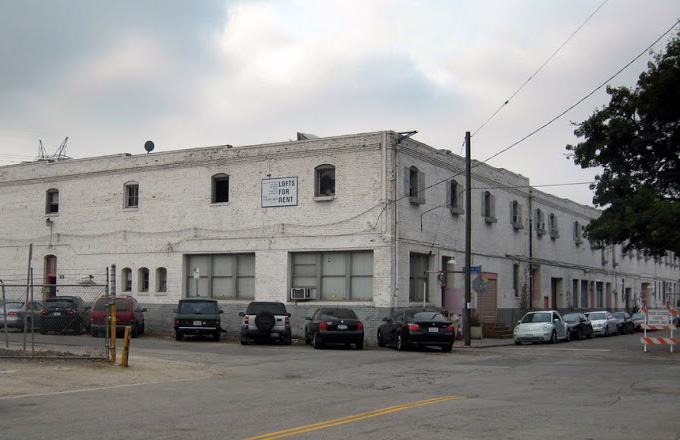
Save the Pickle Works Building – AD Community Meeting!
Please join the LA Conservancy, LARABA, LA Arts District Historical Society and Council District 14 for this incredibly important meeting and voice your concerns about the future of the Pickle Works Building:
LARABA Board Meeting
Monday, April 1
6:30 p.m.
ArtShare, 801 East 4th Place, Los Angeles
Representatives from the City’s Bureau of Engineering, Councilmember Huizar’s Office, and Artspace are expected to be in attendance. Hosted by the Los Angeles River Artists and Business Association (LARABA) and Los Angeles Downtown Arts District Space (LADADSpace)
Pickle Works Building
Photo courtesy of kevinbreak.com 
Contrary to a longstanding agreement, the Los Angeles Bureau of Engineering has proposed to demolish the historic James K. Hill & Sons Pickle Works Building in the Arts District.
The industrial building is over a century old and has been determined eligible for listing in the National Register of Historic Places. Few Victorian-era brick industrial buildings of this type remain in Los Angeles, making the Pickle Works Building a rare and important historic resource.
The building sits next to the 1929 First Street Viaduct, which has been expanded to accommodate light rail. The Bureau of Engineering (BOE) purchased the Pickle Works Building to facilitate the bridge expansion, which required removing part of the building along its south end.
Pickle Works Building cut in two
2009. Photo courtesy you-are-here.com
An agreement made in 2005 allowed the City to remove either 30 or 50 feet of the building and calls for the City to rebuild the south wall “in a manner consistent with the design of the remaining elements of the building.” A recent structural engineering report commissioned by the City states that this is feasible and provides recommendations for implementation.
About the Building
Pickle Works Building
Photo courtesy of kevinbreak.com
 The Pickle Works Building was built in 1888 for the California Vinegar & Pickle Company, later known as the James K. Hill & Sons Company. As with many industrial structures, the building was expanded over time, in several phases, until around 1909. The additions used the same structural wood frame system with brick masonry walls and matching design details.
The Pickle Works Building was built in 1888 for the California Vinegar & Pickle Company, later known as the James K. Hill & Sons Company. As with many industrial structures, the building was expanded over time, in several phases, until around 1909. The additions used the same structural wood frame system with brick masonry walls and matching design details.
A variety of tenants have occupied various portions of the building throughout its history. In the 1980s and ’90s, it was known as the Citizens Warehouse and Art Dock, housing contemporary artists.
In 2005, the Pickle Works Building was determined eligible for listing in the National Register of Historic Places as a rare, surviving example of a Victorian-era brick industrial building.
The Agreement
Interior of Pickle Works Building, stairs looking up from Unit 1 and 1A. Photo courtesy kevinbreak.com
Because the First Street Viaduct expansion used federal funds, and both the Viaduct and Pickle Works Building are eligible for listing in the National Register of Historic Places, a Section 106 process was required to consider alternatives and possible mitigation. Through this process, the expansion project was determined to have an unavoidable adverse effect on the Pickle Works Building as well as the First Street Viaduct.
This determination required a Memorandum of Agreement (MOA) documenting agreed-upon measures that the City will take to avoid, minimize, or mitigate the project’s adverse effects. To minimize adverse effects, the City was responsible for securing the Pickle Works Building following its partial demolition and constructing a new south end wall.
However, the BOE has removed 75 feet—nearly thirty percent of the building—for reasons that are unclear. Perhaps this decision was prompted by a desire for a larger staging area; perhaps it was to ensure structural stability by severing the building in a structurally sound location. The City has since proposed demolishing the rest of the building.
The Conservany’s Position
Pickle Works Building, severed end wall. Photo by Adrian Scott Fine/L.A. Conservancy staff.
The Conservancy wants to work with the City to implement the terms of the MOA . We believe that once a new south end wall is constructed, the best course of action is finding a new end user for the building who will complete its full rehabilitation.
We hope to work with the City to explore a Request for Proposals (RFP) process to transfer ownership of the building into private hands, with conditions to ensure that it is sensitively rehabilitated and protected in the long term.
If the City amended the MOA to allow for the demolition of the remainder of the building, we believe that this process would require a reopening of the environmental review process and likely lead to additional time delays. The Conservancy will want to participate as a consulting party in the Section 106 process matter. We urge the City to convene a community meeting with residents of the Arts District to discuss preservation alternatives.
